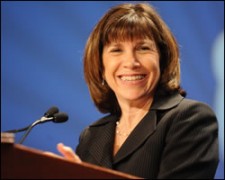What 46 Percent of Small Businesses Want But Can’t Get

Small and microbusinesses are vulnerable – especially when it comes to getting credit. And in the absence of traditional forms of credit, many turn to credit cards for working capital. But 46 percent of SMBs say they don’t or can’t. MasterCard and Corporation for Enterprise Development (CFED) talked to 700 small business owners to understand how their financing options vary by type, age and size of business. Jay Singer, Group Head of Commercial Products for MasterCard, and Andrea Levere, President of CFED shared those insights with MPD CEO Karen Webster yesterday. Listen in on their conversation.
Small and microbusinesses make important contributions to economic development in the U.S., yet many are still not up quite up to par with larger businesses in terms of the resources to which they have access. Credit cards are key in helping get businesses off the ground, but not all are using them, largely because they simply do not qualify. In a 2013 CFED report, 716 microbusiness owners were surveyed, the responses of whom where crucial in helping us understand their vulnerabilities and what must be done to keep them afloat. To elaborate on key CFED findings and give us an idea of how small and microbusinesses, together with financial institutions, can get ahold of essential tools, MPD CEO Karen Webster spoke with CFED President Andrea Levere and Jay Singer, Group Head of Commercial Products for MasterCard.
KW: It’s fair to say that many small and medium size businesses and often turn to credit cards to help get their businesses started and provide working capital along the way. Is this what you’re observing?
JS: Yes, I think small businesses are looking at all types of financing options from personal savings to loans from family friends. Cards, however, are an important aspect in getting started and operating their businesses. They help with working capital and cash flow control – and the convenience of having a card is important, too. We are also seeing the blending between personal and business expenses. We look at that and we see the linkage between where cards play a role.
AL: The results of the CFED study, after surveying over 700 microbusiness owners, show that there are many issues that we can seek out in terms of what’s happened with the great recession with access to credit, and the ability of business owners to qualify. When we looked at the use of credit among all of these business owners, we found that only about 1 in 3 used credit of any kind. And then we saw, of the business owners that did have access to credit, about 54 percent were using credit cards. There was also a pattern in terms of when a business owner begins using personal credit and the steps they take to then use business credit. We also can see the larger picture, and we can ask how they develop the financial skills and credit history to then make that change.
![Business Credit Cards Business_Savings[2][1]](http://www.pymnts.com/wp-content/uploads/2014/05/Business_Savings21.png)
KW: Let’s start with talking about the use of credit cards as a method of financing business. Are these small businesses just not looking for other ways to get credit, or are they unable to get access to credit?
JS: I think it’s the latter. The small businesses themselves have sought out their family and friends first to help them finance, and they realize later that a credit card can help them kick-start their business. We might think that small businesses are currently so dependent on cards, but 46 percent are not usingcards. Those 54 percent that are using cards are benefited especially in terms of managing cash flow, getting that control aspect. It’s a simple and easy way to make purchases, and helps with day-to-day transactional engagement, as well as longer-term cash management.
KW: Andrea, you mentioned something about financial education, or giving SMBs the chance to better utilize these tools. How does this play into this portfolio of credit card use and the important role that it plays in helping small businesses grow?
AL: I spent the first decade of my career doing small business finance, and one of the things I learned was that virtually no one goes into small businesses because they love finance. But, once you get through the startup period, if you don’t understand how money flows through your business, and if don’t understand how best to match sources and uses of funds, you are not going to be successful.
There are two sources of advice and counsel around this to really help business owners. Going back to what Jay said about what the main use of credit cards has been in the study, it was really a vital tool to help manage cash flow challenge. We’ve seen the growth of alternative financial businesses that are providing short-term credit of rates of up to 460% percent. Suddenly, a credit card is a high quality tool to really help cash flow problems. And I think financial services companies understand this because they want their customers to use the tools in the right way.
KW: Let’s move on into how the use of financial products differs among different types of businesses. What are you seeing in terms of the way in which credit card products are being used by these businesses in different stages and phases of growth?
JS: First of all, small and micro businesses are really the lifeblood of the community. What we are striving for at MasterCard is to create ways to give them the access to solutions that large businesses have taken for granted. For example, we’ve created savings programs like the MasterCard Easy Savings platform. And as a business gets a little larger, they have a need for true purchasing power against that of a large company. We see that within our MasterCard Business Network, which provides access to items that small businesses buy every day at incredible discounts, as well as a travel booking engine that competes with what big companies use. We want to make it easy and simple for small businesses to manage their finances.
KW: Do you think that the challenges that this group of small businesses is facing today are different from a decade ago?
AL: There are two issues. One is the impact of the recession and what that did with credit – that is still shaping the environment, and leading us to do some creative things, especially in the case of MasterCard. But we still have a real issue for SMB credit in this country, and we have discovered how critical it is to have savings to really build the financial strength of a business. As Jay described, creating products that have “guardrails” on them that allow you to do a set of transactions without getting into trouble is one of the most positive developments for financial institutions in the marketplace. The other huge change in financial services is how technology has transformed everything, both positively and negatively. We have an interesting combination of the macroeconomic environment, the broader technology changes, and the realities of what it takes to manage a business in a marketplace that’s increasingly competitive.
KW: Let’s close out where we started. One of the statistics that you cited early on was that 54 percent use credit cards, and 46 percent do not. What should small businesses do in terms of not getting access to credit? Is there anything they can do?
JS: Financing is important and critical, but it is not the only issue. Getting access to credit is a challenge. We are constantly looking at ways to help banks make better decisions based on different data, and we are looking at partnerships with alternative lenders in the space that bring different views from a technology perspective. These alternative lenders bring different scoring models and values of criteria for the banks to improve the offer of credit. Another area we’re focusing on is helping small businesses accept cards – if they can do that, there will be a guaranteed flow of revenue that can help banks make credit decisions.
AL: Your credit score is your passport into the economy. The message by which we are calculating and using credit scores needs to be reinvented in many ways. We have people in the nonprofit, private, and public sector looking at ways that we can track and collect data to create a broader, more nuanced picture of the credit strength of the entrepreneur. Also, there have been creative methods ranging from lending circles to bring folks with no credit score into the financial mainstream, as well as online models to offer credit. Lastly, we need to continue to link savings and credit. There’s a huge part of a business that requires equity, and the equity for most of these companies comes from family and friends. But if you are not part of networks that have those resources, you start behind the 8 Ball. So the question is: How do we help everyone build these savings can in turn strengthen their business?
For more on the findings of the CFED report and what MasterCard is doing to help small and microbusinesses gain access to credit and other key tools, listen to the full podcast here or read the full MasterCard news brief here.
Listen to the full podcast by clicking below.
*If you have trouble with the audio player above, click here.
Jay Singer
Group Head, U.S. Commercial Products
Jay Singer is group head, U.S. Commercial Products at MasterCard Worldwide. In this role, he leads the U.S. development and commercialization of the MasterCard innovative commercial products and solutions that serve small businesses, mid-to-large market organizations and public sector institutions.
Mr. Singer joined MasterCard in 1997. He began his career as director of Marketing Consulting where he supported the acquisition, portfolio management and product development programs of our U.S. customers. In 2000, he moved to Hong Kong where he spent four years establishing the MasterCard Advisors business in Asia as a business development and consulting lead.
In 2004, Mr. Singer joined the Citi Global Account team as account leader, for the U.S. Small Business and Diner’s Club portfolios. He was elevated to general manager, Global Strategy and Implementation, where he was responsible for strategy, business development and implementation for all Citi portfolios globally.
Prior to joining MasterCard, Mr. Singer held several roles of increasing responsibility in the Consumer Cards Group at American Express. His experience included customer acquisition, portfolio management, new product development, co-branding and relationship management. He also held sales and account management positions at the consumer product company Keebler.
Mr. Singer holds an M.B.A. from the Stern School of Business at New York University, and a B.S. in Marketing from the Pennsylvania State University.
Andrea Levere has led the Corporation for Enterprise Development (CFED) as its president since 2004. CFED is a private nonprofit organization with the mission of building assets and expanding economic opportunity for low-income people and disadvantaged communities through matched savings, entrepreneurship, and affordable housing.



